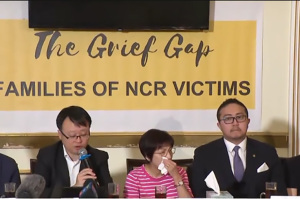Trump admin sued over new refugee executive order; advocates want clarity

The International Refugee Assistance Project filed a lawsuit seeking answers on how President Donald Trump’s executive order giving states and localities the ability to block refugee resettlement was created as questions remain about how it’ll be implemented.
IRAP, which provides legal aid for refugees and displaced people worldwide, including Christians, filed a Freedom of Information Act lawsuit Monday to compel the U.S. State Department to release critical information about the new order issued last week.
The order was issued on the same day the administration announced it would reduce the annual refugee resettlement ceiling to a historic low of 18,000. The legal complaint claims the order “gives state and local governments an unprecedented power” to refuse to accept refugees in their jurisdictions.
Such power, IRAP argues, was previously only reserved for the federal government.
Under the order, refugees can only be resettled in jurisdictions that consent to have refugees resettled there.
“Under this new policy, a governor or locality may block refugees from being resettled in their jurisdictions even if a community of people stands ready to welcome them,” the complaint reads, “even if family members have been awaiting their arrivals, even if resources and opportunities available make it the best place for those refugees to rebuild their lives, and even when the desire to keep them out is based on where they are from, the color of their skin, or how they pray.”
The executive order contends, however, that the policy ensures that communities are "eager and equipped to support their successful integration into American society and the labor force."
A State Department spokesperson declined to comment on the pending litigation.
IRAP claims that its Freedom of Information Act request, submitted more than two months ago for documents related to the anticipated policy, was “foreshadowed by the 2017 Executive Order imposing a [temporary] ban on refugees and travelers from several predominantly Muslim countries,” and reducing refugee resettlement that year to 50,000.
But to date, IRAP has only received an acknowledgment from the department that its request was received. IRAP hopes the federal court will compel the disclosure and release of “urgently needed records that this administration has unlawfully withheld from public scrutiny.”
“There is an urgent need to know more about this unprecedented policy,” IRAP senior litigation attorney Melissa Keaney said in a statement.
“Through this litigation we hope to shed light on how the Trump administration is abdicating its responsibility to administer the refugee resettlement program by providing states and localities with the ability to block resettlement."
The lawsuit argues that the role of state and local officials in refugee resettlement has been a subject of litigation, including the Seventh Circuit’s 2016 decision striking down then-Governor Mike Pence’s attempt to block Syrian refugees from being resettled in Indiana.
IRAP also requested information on two other policy changes previously announced by the administration but no details have yet been made publicly available.
The first is a policy created in the administration’s refugee admissions proposal submitted to Congress for the fiscal year 2018 that would place more emphasis on “assimilation criteria.”
The other policy change was indicated in a funding notice for the fiscal year 2019 that the number of nonprofit agencies authorized to resettle refugees in the U.S. would be cut from nine to an unspecified number.
No details have been released about either policy, though the number of authorized resettlement agencies remains at nine.
The State Department and HHS were given 90 days to develop and implement a process to determine which states and localities have consented to accept resettled refugees.
The administration set a refugee resettlement ceiling of 18,000 for fiscal year 2019, a little more than half of the 30,000 refugees that were resettled in the fiscal year 2018 and a fraction of the 85,000 refugees that were resettled in the final fiscal year of the Obama administration, the highest number admitted under his term in office.
Among refugee resettlement advocates, questions remain as to what impact the executive order will have.
“There's a lot that we don't know yet about what this process is gonna look like because the executive order says that within 90 days there should be a process,” said Matthew Soerens, director of U.S. church mobilization for the evangelical resettlement agency World Relief.
“So for example, it does say it will be necessary to have written consent from state and local governments. It's not clear what unit of local government we're talking about. Is that a county board? Is that the mayor? Some communities have a village board. Do you need every village board member’s consent? A majority?”
Soerens, who also serves as national coordinator of the Evangelical Immigration Table, warned on a press call that it could be logistically complicated even for communities and states that consent to resettlement.
He also said that it could create some “ugly political battles” at the local level.
“What happens if the governor says yes but the mayor says no or vice versa? There are a lot of questions there that remain unclear,” Soerens explained.
“Even in communities where 55 percent vote to allow resettlement, refugees will be coming into a community where there has been an ugly political battle at the local level and I worry that will be taken out against refugees themselves once they arrive. We saw a little bit of that when it became a political battle in 2015, but I can see it being exacerbated by this sort of policy.”
While some communities might choose not to allow refugee resettlement, Soerens does not believe that it will prevent refugees from residing wherever they want once they are lawfully present in the U.S.
“Presumably, we are talking about where refugees can resettle, not where they can reside once they are already in the United States,” Sorens said. “Because refugees are lawfully present immigrants, they have the same rights and mobility as any other lawfully present person in the United States.”
Dan Kosten, assistant director for skills and workforce development policy and advocacy at the National Immigration Forum, stressed on the press call that the reason why the federal government has such broad powers when it comes to the refugee resettlement issue is to avoid a “bureaucratic nightmare.”
He warned that there are “so many things that could potentially go wrong.”
“I can hardly imagine 50 states and how many localities in each state having to determine whether or not they're going to accept that refugees resettlement in those localities,” he stressed. “What about just the bureaucracy of collecting all these written consents, compiling it and figuring out who has agreed to it and who has not and where can we send them and not send them?”
“What the government is in effect saying is the default is nobody is going to be accepting refugees,” Kosten argued. “The only way you're going to get them is if you actually put it in writing that you want them.”
The decline in refugee resettlement over the last few years has had a significant impact on the network of refugee resettlement agencies as all nine have had to close down offices.
A report from the Refugee Council USA released earlier this year suggests that 100 resettlement agency offices nationwide have either closed or ended their resettlement programs.
World Relief, the humanitarian arm of the National Association of Evangelicals, has closed seven offices, according to Soerens.
“One of the open questions is how many resettlement agencies the State Department thinks they need to resettle 18,000 refugees. At the moment, all nine agencies have been given a 90-day extension into the new fiscal year,” Soerens said.
“That is how it happened last year too. But that is not how it used to work. We used to be given annual contracts. We entirely hope and intend to be part of the U.S. Refugee Resettlement Program which we have done since 1979. I think all other agencies have the same hope but I don’t know what the State Department will decide there.”
Follow Samuel Smith on Twitter: @IamSamSmith
or Facebook: SamuelSmithCP





























